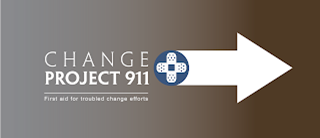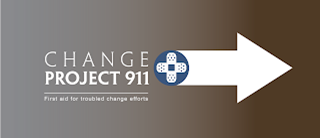Thank you for coming along on this Change Project 911 journey with Mat Roosa, the guest blogger for the series. Below you will find a list of all the Change Project 911 NIATx series with a short blurb. Select the title to read the full content of each blog.
Help! My Project is Dragging on Too Long
Posted December 29, 2020
Change projects are not meant to be open-ended.
They’re meant to move quickly and efficiently to extract the maximum benefits.
Dave Gustafson, who developed the NIATx model, recommends limiting change
projects to no more than a few weeks. Some change projects can be completed
successfully in as little as a day. If you find your team in the middle of a
never-ending project, try to diagnose the root cause that’s derailing the
project.
Any one of these underlying problems could make a change project drag on. . .
Help! My Change Team has lost its energy!
Posted February 10, 2021
Sometimes a change team can feel like a phone with only 2 percent battery life left. Some teams start with a full charge that drains through time. Other teams get started with a lower level of energy and go downhill from there. The challenge of COVID-19 and other competing priorities and stressors can quickly diminish a change team’s energy and divert attention from the change project. The fix. . .
Help! Our change project is unmanageable!
Posted March 15, 2021
Basket or cart?
It’s the first decision we usually make when we enter a large grocery store. When I am just buying a few items, I usually pick up a basket so that I can move more easily through the store. Often I find myself with a gallon of milk in one hand, an overflowing too heavy basket in the other, and wondering why I did not get a cart in the first place. So, what can we do to keep from overloading the process?. . .
What to Do When the Idea Well Has Run Dry
Posted April 8, 2021
Generating change ideas requires time and energy. Teams lose momentum when initial change efforts don’t succeed, and then struggle to develop option B (or C) to continue their improvement efforts. As teams attempt to move multiple priorities forward, they lose energy to exploring new ideas. Worst case scenario? They feel like just giving up and tolerating the problematic status quo.
So what is a busy team with limited resources to
do? How can your team develop a new vision? The five ideas that follow can help
organizations to generate new ideas to get the change process moving again. . .
The Incomplete Walk-through
Posted May 24, 2021
Understand and involve
the customer.
This is the first and most important of the five NIATx principles. Much of our NIATx work involves working to understand the customer/client/patient experience—because the customer experience is the critical factor in all service delivery. Strategies to understand and involve the customer can include client interviews, focus groups, or including clients on a change team. . .
Counting what Counts: Addressing the challenge of incomplete data collection
Posted July 23, 2021
“Help! We don’t know if our change is an improvement!”
At the foundation of all quality improvement
work lies data.
Imagine driving down a twisty road at night and having your headlights turned off for a portion of the journey. That’s what happens when we try to manage a change project without consistent data access. It can be helpful to think about the data needed to steer a change in three stages:. . .
When Your Rapid-cycle PDSA is Not Working
Posted August 26, 2021
Rapid-Cycle Plan-Do-Study-ACT (PDSA) is a powerful tool for improvement that can enable a team or organization to achieve its short-term goals and move toward long-term success. But sometimes, PDSA change cycles do not yield the desired results. Here are a few questions to consider when your change project does not achieve the goal. . .
Help! How do we deal with change project interruptions?
Posted September 17, 2021
Maintaining forward momentum on top priorities
Once your team has developed a change project and you have strong executive support, it might seem like things should be smooth sailing. But there are a number of ways that a strong project can be blown off course. . .
Customers don’t notice improvements
Posted October 18, 2021
How do we know if a change is an improvement?
Change teams and change leaders ask this question frequently. It often refers to the measures and data they’re using to monitor change results.
But there is another and perhaps more meaningful way to ask this question: How do our customers know that a change is an improvement? . . .
Unable to sustain a change
Posted November 19, 2021
“It’s easy to quit drinking. I’ve done it a thousand times.” W.C. Fields
Change is easy. Sustaining change is not so easy. This is true for personal changes like quitting smoking, exercising more, driving slower, or keeping the house more organized. It is also true for workplace systems changes, such as implementing new policies and procedures. Too often, despite our best intention, we end up like Sisyphus, doing our best to roll the change up the hill, only to see it slide back down. . .
No Time for a Change Project: Finding Time vs. Making Choices
Posted January 3, 2022
Why do so many good change ideas end up at the bottom of the pile? Why do most teams struggle to find the time, energy, and people to implement change projects? Many teams are convinced that they cannot control the urgent needs, staffing and fiscal resource demands, and other obstacles that get in the way of change implementation. This might be because they are asking the wrong question. . .
About our Guest Blogger
Mat Roosa, LCSW-R was a founding member of NIATx and has been a NIATx coach for a wide range of projects. He works as a consultant in quality improvement, organizational development and planning, and implementing evidence-based practices. His experience includes direct clinical practice in mental health and substance use services, teaching at the undergraduate and graduate levels, and human service agency administration. You can reach Mat (Change Project SOS) at matroosa@gmail.com.




